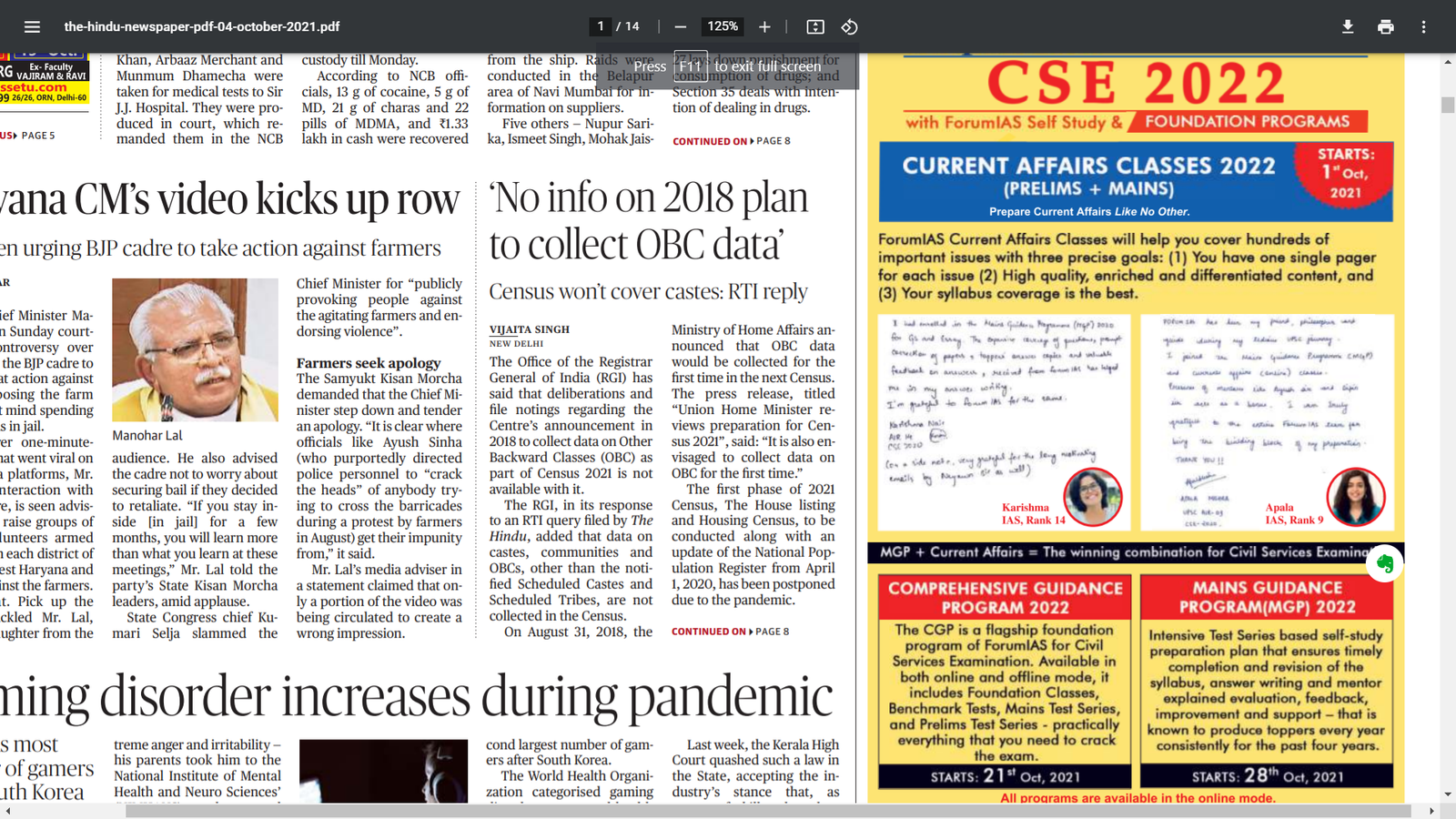
Prepare IAS Coaching
Current Affairs

Title : CASTE CENSUS
Date : Feb 07, 2022
Description :
Based on an News Article published in the ‘The Hindu’
Useful for UPSC CSE Prelims and Mains (GS Paper II)
What is Caste Census:
- Every Census in independent India from 1951 to 2011 has published data on Scheduled Castes and Scheduled Tribes, but not on other castes.
- Before that, every Census until 1931 had data on caste.
- However, in 1941, caste-based data was collected but not published.
- In the absence of such a census, there is no proper estimate for the population of OBCs, various groups within the OBCs, and others.
- The Mandal Commission estimated the OBC population at 52%, some other estimates have been based on National Sample Survey data.
- Some political parties make their own estimates in states and Lok Sabha and Assembly seats during elections.
Arguments for Caste Census:
- A caste census is not merely geared to the reservation issue.
- Enumerating the marginalized:
- A caste census would actually bring to the particular the number of people who are at the margins, or who are deprived, or the kind of occupations they pursue, or the kind of hold that institutions like caste have on them.
- Data for Policymaking:
- This information is absolutely necessary for any democratic policymaking.
- Judicial backing:
- The courts in India have often emphatically said that it is important to have adequate data with regard to the reservation.
- Caste offers privilege:
- Caste is not only a source of disadvantage; it is also a very important source of privilege and advantage in our society.
- Caste doesn’t marginalize:
- We need to do away with the idea of caste being applicable to only disadvantaged people, poor people, people who are somehow lacking.
- Rids away caste rigidities:
- Counting of caste doesn’t necessarily perpetuate caste or the caste system. Myths of caste elitisms can be debunked through a caste census.
Arguments against Caste Census:
- 50% breach:
- It is argued that a Socio-Economic Caste Census is the only way to make a case to breach the 50% cap on reservation and rationalize the reservation matrix in the country.
- Rising assertiveness:
- More the State ignores out caste, the more is the tendency to preserve caste, protect it. This has been observed in many states.
- Chaos:
- Data gathering itself is a big problem because it can become very, very invasive.
- But we need to actually balance it with enabling people and asserting citizen equality.
- Social friction:
- Caste identification can lead to friction amongst various classes.
Breaching the 50% Gap:
- Judicial Substantiation:
- The 50% cap, as introduced by the court, has not really been argued through.
- Questioning the sacrosanctity:
- Some feel that nothing sacrosanct about the 50% limit − it can be exceeded, if necessary, but a clear argument should be given for why this is being done.
Inefficiency of reservations:
- Fractional benefits:
- The way reservation is practiced has invariably led to elites among castes and communities.
- Domination:
- These elites within the castes have tended to exercise their dominance over their very communities and not let them exercise the kind of freedoms, or search for equality, which any democratic polity deserves.
- Welfare isn’t reservation:
- The state has helped privileged communities far more, even though this help has not taken the explicit form of programs like reservation.
Why is Caste Census always controversial:
- Data manipulation:
- This is a manifestation of the principle that those in power control data and information.
- Censoring of data:
- We have had instances where this data has been collected but has not been made public.
- Relative deprivation:
- Since a caste census is a necessity, it is not a happy thing, it is not a great achievement, it is just something that the State has to do circumstantially.
- Vote bank politics:
- Vested interests of particular state governments in hunt for vote banks are also visible these days.
Socio-Economic Caste Census (SECC) is the solution:
- We have got locked into a mindset where we think only those communities which want welfare benefits from the state must be enumerated.
- Many have argued that a Socio-Economic Caste Census would be the best way to rationalize reservation based on data and make a strong case for breaching this gap.
- Earlier governments argued that counting caste will perpetuate it.
About SECC:
- The Socio-Economic and Caste Census (SECC) was conducted in 2011.
- It was the largest exercise of the listing of castes and has the potential of finding inequalities at a broader level.
- Socio-Economic Caste Census(SECC) was conducted by the Ministry of Rural Development in rural areas and the Ministry of Housing & Urban Poverty Alleviation in urban areas.
- The SECC data excluded caste data and was published by the two ministries in 2016.
- The raw caste data was handed over to the Ministry of Social Justice and Empowerment,
- The Socio-Economic and Caste Census (SECC) was conducted in 2011.
- The ministry formed an Expert Group under former NITI Aayog Vice-Chairperson Arvind Pangaria for the classification and categorisation of data.
- However, only the details of the economic conditions of the people in rural and urban households were released.
- The caste data has not been released till now.
Way Forward:
- Instead of going behind the caste based census, the government can subclassify the Backward Classes like in Tamil Nadu, Andhra Pradesh, West Bengal etc.
- This will provide the benefit to intended beneficiaries.
- Since the government has already appointed Justice G Rohini Panel on Sub-categorisation of OBCs.
- The Panel has to fast pace the sub-classification process.
- Reservation is one among many considerations which affect competition among candidates.
- So, the 50% limit can be extended to the proportion of backward classes population in our country.
- Use technologies to assess the caste date on SECC: The government can use technologies like Artificial Intelligence and machine learning to assess the SECC data and condense them into meaningful categories.
- After that, the government can reveal some important caste-based information. This will provide the necessary time to analyse the need for a caste census.
- Favouring one caste becomes a disfavor for others.
- This is an undeniable fact of Indian society.
- It seems that the caste census will happen unless something extraordinary happens in our polity.
- There are also important questions of demands coming up because of mismatches between the numbers that we come out with and the share in resources that different communities have.
- This is a kind of nightmare that all governments fear.
- So, they would much rather leave things vague.
- The Backward Classes are more than 50% of the population.
- And this dispensation knows that it cannot afford to lose the support of the Backward Classes.
